How to turn off the computer automatically
Automatic computer shutdown timer allows you to schedule a computer shutdown on Windows 10, Windows 7/8 even without sitting in front of the computer.The ways to turn off the computer below are quite easy to use on operating systems, please consult.
Turning off your computer is quite simple, just press Start / Shut down, then click once more Shut Down again. However, to schedule a computer shutdown , you will have to use a little more tricks, but you cannot use the regular Shut Down button.
In this article, TipsMake.com will introduce you to two ways to timer off the computer on Windows 7, Windows 8, Windows 10 , can even apply both on Windows XP and older versions.
The ways to turn off the computer automatically
- Timer to shutdown with CMD command
- Automatic computer shutdown by shortcut
- Automatic computer shutdown timer with Windows Task Scheduler
Timer turns off the computer with CMD command
With the following simple CMD command, you can schedule your computer to turn off after a certain amount of time. Open CMD with Windows + R shortcut key combination and enter the following command, or on Windows 10 you can enter the command directly into the search bar:
shutdown -s -t 1800 In the computer shutdown command on:
- shutdown: Turn off the computer
- -s: shutdown stands
- -t: Abbreviation of time
- 1800: The number of seconds remaining before the command is executed, you can change 1800 (1800 seconds, equivalent to 30 minutes) to whatever time interval you want.
- 3 minutes: shutdown -s -t 180.
- 5 minutes: shutdown -s -t 300.
- 10 minutes: shutdown -s -t 600.
- 15 minutes: shutdown -s -t 900.
- 30 minutes: shutdown -s -t 1800.
- 1 hour: shutdown -s -t 3600.
- 2 hours: shutdown -s -t 7200.
- 3 hours: shutdown -s -t 10800.
- 4 hours: shutdown -s -t 14400.
- 5 hours: shutdown -s -t 18000.

Enter the timer command to turn off the computer in the Run window
After entering the command you will receive a small notification in the right corner of the screen, indicating the time the computer will turn off.
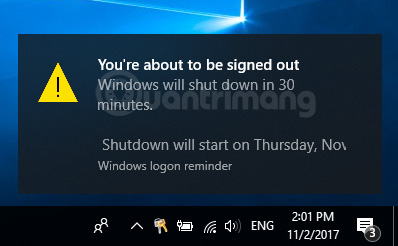
Notice that the time will turn off the computer
If you need to cancel the timer to turn off the computer you just created, simply press Windows + R and then enter the following command or enter the command into the search bar on Windows 10, Windows 7, Windows XP:
shutdown -a 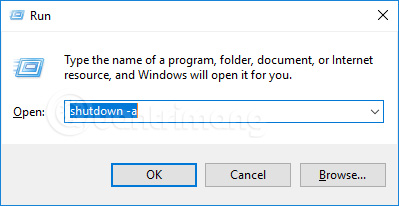
Cancel the timer command to turn off the computer
Then the computer shutdown timer command message will be canceled as shown below:
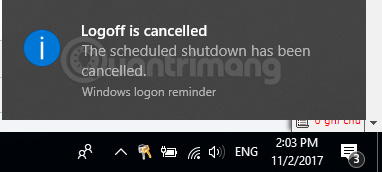
The computer shutdown timer command has been canceled
Automatic computer shutdown by shortcut
To create the Shutdown.exe shortcut, do the following:
Step 1: Right click on the desktop> New> Shortcut
Step 2: Browse to the Shutdown.exe file that usually has the C: WindowsSystem32Shutdown.exe path> Next
Step 3: Name the shortcut> Finish
Step 4: Right-click the newly created shortcut and select Properties
Step 5: In the Target box enter the following command to shutdown
- -s: Turn off the device
- -l: Log off
- -r: Restart the device
Step 6: Enter -t xx after the above command to schedule a shutdown (xx is the number of seconds waiting to shutdown)
Step 7: Add -c "text" after the above command to say something when the computer is turned off
The following operations will appear as follows:
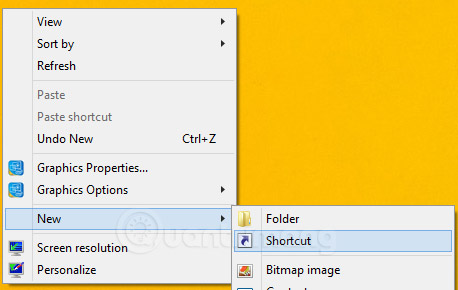
Step 1: Select the Shortcut in the menu that appears
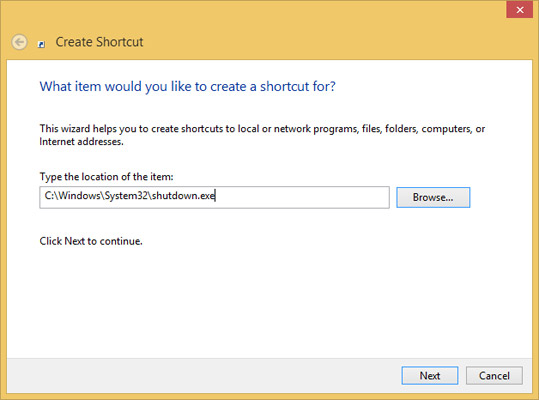
Step 2: Find the shutdown.exe file
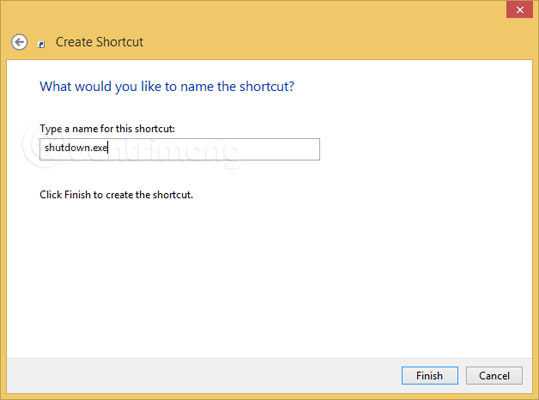
Step 3: Click Finish to complete
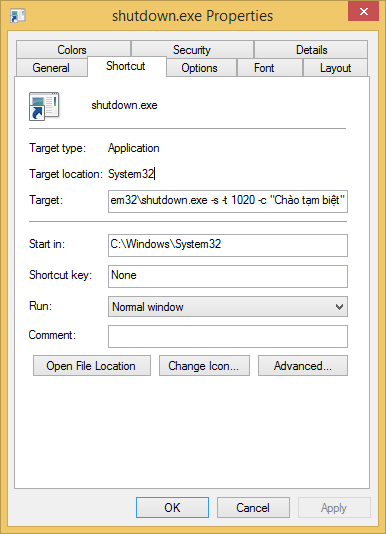
Step 4-7: Order entry -s -t 1020 -c "Say goodbye"
(automatically shutdown after 1020 seconds and the message "Say goodbye")

Notice of the system when double-clicking the shortcut file to turn off the computer
Automatic computer shutdown timer with Windows Task Scheduler
If you combine the shortcut Shutdown.exe just created with the Windows Task Scheduler, you can schedule a shutdown of your computer, so you won't have to worry about turning off your computer at the end of the day. This is especially useful for computer managers who are full of computers, if they turn off the computer normally, it will take a long time.
To schedule a computer shutdown, do the following: Go to Control Panel , open Scheduled Tasks , then double-click Add Scheduled Task . In the Scheduled Task Wizard dialog box, click Next , then select the Browse button and navigate to the file: Windowssystem32shutdown.exe . Put a name you want and select the Daily option. Choose the time of day you want the computer to turn off. After that, a dialog box will appear asking for a username and password; You can fill or skip.
Before pressing the Finish button to finish, please put a checkmark in the Open advanced properties for this task when I click Finish button . This way you can set additional options for timer shutdown. In the dialog box that appears, in the Run box, append –s to the command line and -t xx statements (xx is the number of seconds to turn off the machine) and -c "the word you want" (for example, say 'Goodbye 'according to this article) (should know that the command -t xx and -c ' the word you want 'can be ignored).
Before clicking the OK button to close the dialog box, click your mouse on the Settings tab and put a checkmark in the Only start the task box if the computer has been idle for at least:, then set the time you find appropriate for you.
How to schedule a computer shutdown according to the above instructions for computers running Windows XP. To set the time to turn off the computer in Windows Vista, the steps are similar. Instead of opening Scheduled Tasks in Control Panel, you can select Task Scheduler from the Start menu, in the Run box, type taskschd.msc . Then, in the right pane, click Create Task .
In the dialog box that appears, give the name you want in the General tab. In the Triggers tab, create New trigger . Select On a schedule , and specify the time, then place a checkmark in the Enabled box at the bottom. From the Actions tab, select Start a program , navigate to the file: C: Windowssystem32Shutdown.exe , and set the command like you would with Windows XP ( -s to shutdown, -r to reboot and -l to log off) . Finally, in the Conditions tab, put a checkmark in the Start the task only if the computer is idle for: box , and select a time you find reasonable for you.
If you're using Windows 10, you can refer to other ways to turn off another computer at: Instructions for scheduling a Windows 10 computer shutdown
You should read it
- Shutdown command - Schedule the shutdown of Windows 10 with the Shutdown command
- Software timer shutdown
- Instructions for scheduling a Windows 10 computer shutdown
- Top 5 best automatic computer shutdown software
- Shutdown timer on Windows 10 is very simple with the command Shutdown -s -t
- 4 How to schedule shutdown of Windows 11 computers without software
- How to use the Shutdown command to schedule shutdown and restart the computer
- Trick to turn off the computer from the right-click menu on Windows 8
May be interested
- How to prevent WiFi automatically turn on on Android
 you may find that wifi on android phones automatically turns on when you're near known or strong networks. in today's article, tipsmake.com will show you how to prevent android phones from turning on wifi automatically.
you may find that wifi on android phones automatically turns on when you're near known or strong networks. in today's article, tipsmake.com will show you how to prevent android phones from turning on wifi automatically. - Custom instructions turn on, turn off Autoplay in Windows 10
 autoplay feature to detect the type of device you have attached and automatically perform any tasks you require. however, this feature automatically runs on the system when connecting devices, usb, drives, ... can be dangerous to the computer.
autoplay feature to detect the type of device you have attached and automatically perform any tasks you require. however, this feature automatically runs on the system when connecting devices, usb, drives, ... can be dangerous to the computer. - Fixed a bug when Libraries folder opened automatically when booting the computer
 this is the situation every time you start your computer, the libraries folder will automatically turn on even if you don't have anything installed. the cause of this error is caused by a virus that destroys the usernit value, duplicated in the windows registry. therefore, you have to go to start up to edit it is also useless. here, tipsmake.com will guide you how to fix this error.
this is the situation every time you start your computer, the libraries folder will automatically turn on even if you don't have anything installed. the cause of this error is caused by a virus that destroys the usernit value, duplicated in the windows registry. therefore, you have to go to start up to edit it is also useless. here, tipsmake.com will guide you how to fix this error. - How to keep the computer screen on
 on windows operating systems always turn on the feature to automatically turn off the screen or put the computer to sleep mode for a certain period of time to protect the screen in case you leave out or hang up for a long time. if you want to keep the screen on, you must turn off the feature mentioned in the following tutorial.
on windows operating systems always turn on the feature to automatically turn off the screen or put the computer to sleep mode for a certain period of time to protect the screen in case you leave out or hang up for a long time. if you want to keep the screen on, you must turn off the feature mentioned in the following tutorial. - iPhone does not automatically turn off the screen and suggests a fix for iFan
 hello! today's tipsmake will show you how to fix the error of iphone not turning off the screen automatically. if you are experiencing this situation, please refer to it
hello! today's tipsmake will show you how to fix the error of iphone not turning off the screen automatically. if you are experiencing this situation, please refer to it - How to automatically turn off the computer when downloading files on uTorrent
 on the utorrent software, the torrent file has the feature to automatically turn off the computer after downloading the file and the user does not need to wait to turn off the computer.
on the utorrent software, the torrent file has the feature to automatically turn off the computer after downloading the file and the user does not need to wait to turn off the computer. - How to turn off startup programs on the system in Windows 10
 when installing software on your computer, you will notice that there are some software that automatically run every time you turn on your computer. this is the reason why your computer boots up more and more slowly. to fix this we will turn off startup applications
when installing software on your computer, you will notice that there are some software that automatically run every time you turn on your computer. this is the reason why your computer boots up more and more slowly. to fix this we will turn off startup applications - How to turn off reading PDF files on Coc Coc
 coc coc browser also integrates the feature of reading pdf files automatically. however, this feature sometimes also annoys users when it makes the computer fall into a slow startup, sluggish when opening large pdf files.
coc coc browser also integrates the feature of reading pdf files automatically. however, this feature sometimes also annoys users when it makes the computer fall into a slow startup, sluggish when opening large pdf files. - How to turn off automatic tab sounds on Chrome and Firefox
 suppose you are trying to remain silent when browsing the internet at home, work, or public space but when opening a new tab, a video or advertisement will automatically sound. end that worry forever by keeping all new tabs open 'silent' by default.
suppose you are trying to remain silent when browsing the internet at home, work, or public space but when opening a new tab, a video or advertisement will automatically sound. end that worry forever by keeping all new tabs open 'silent' by default. - How to turn off Firefox automatically restart when entering Windows
 when firefox is turned off, it will automatically reopen tabs when users enter windows. so how to turn off the auto-start firefox feature?
when firefox is turned off, it will automatically reopen tabs when users enter windows. so how to turn off the auto-start firefox feature?










 How to sign in by face, install Face ID on Windows 10
How to sign in by face, install Face ID on Windows 10 5 ways to 'Show desktop' super fast for Windows
5 ways to 'Show desktop' super fast for Windows How to open the Registry Editor on Windows
How to open the Registry Editor on Windows How to open Command Prompt on Windows 10, 8, 7, Vista and XP
How to open Command Prompt on Windows 10, 8, 7, Vista and XP How to use Windows Tweaker 5 to customize Windows
How to use Windows Tweaker 5 to customize Windows Instructions for using voice commands on Windows 10 Fall Creators Update
Instructions for using voice commands on Windows 10 Fall Creators Update